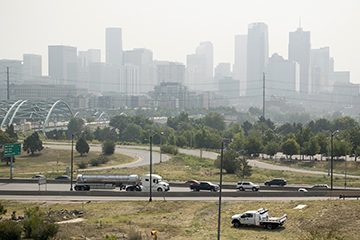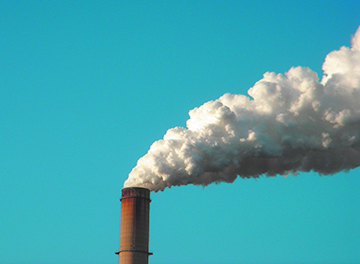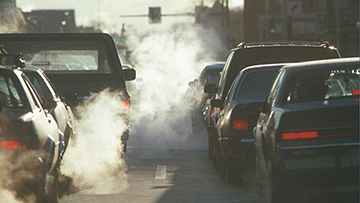Breaking Down Denver’s Rising Levels Of Air Pollution

It’s rush hour on a Denver weekday afternoon and bumper to bumper traffic is making the ride home a frustrating punishment rather than a jettison to freedom. Then suddenly a jogger flies past your window and a pang of guilt overcomes you that you are not getting your cardiovascular exercise for the day.
But is that wannabe Forrest Gump really engaging in a healthy activity? What the exercise-crazed spandex-clad hordes of Denver may not be aware of is that hyperventilating amid throngs of automobiles ain’t all it’s cracked up to be. The air circulating through your lungs is saturated with elevated levels of ozone. On many a smoggy day, (there were over 100 in 2019) the air hanging over the city is what the Environmental Protection Agency calls “in serious violation” of Air Quality Index (AQI) standards. Essentially, by breathing rapidly and deeply next to a busy Denver street, you may slowly be poisoning yourself.
A Man-made Hazard

A series of circumstances have coalesced to form what could be considered a perfect storm of pollution across the city. Increasing volumes of car exhaust due to population explosion, carbon emissions from oil and gas mining operations, smoke from fireplaces and woodburning stoves, emissions from power plants and industrial furnaces and sunlight reacting with molecular oxygen particles has elevated the ozone levels past the 70 parts per billion (PPB) maximum recommended by the EPA. The aforementioned 100+ days in 2019 involved ozone levels past 80 PPB. The national ambient air quality standards (NAAQS) were redefined in 2015 after extensive research into the detrimental health effects of common air pollutants such as ground-level ozone, particulate matter, lead, sulfur dioxide, nitrogen dioxide and carbon monoxide.
In Collaboration With Nature

What’s more, a global warming-driven weather phenomenon known as temperature inversions are acting like an invisible lid — trapping pollution in the troposphere rather than allowing it to dissipate up through the stratosphere. Yes, the infamous brown cloud of the 1980s that Denver was internationally mocked for is back once again. This time around, however, like fugly apartment buildings, a whitewashed retail landscape and gentrification itself — this phenomenon is taking place in metropolitan areas across the nation.
In a nutshell, ground-level ozone is volatile organic compounds (VOCs) and nitrogen oxides (NOx) reacting with sunlight and atmospheric air molecules. The Denver Regional Council of Governments estimates that every day, between 250,000 and 350,000 cars are being driven across the metro region. This transportation sector is the second largest contributor of greenhouse gases next to industrial emissions. Plus, there are over 23,000 active oil and natural gas wells across the front range as well as numerous power plants across the Denver metro region.
A New Agency To The Rescue?
As of January 1, 2020, the Denver Department of Public Works was renamed the Department of Transportation and Infrastructure (DOTI) in a symbolic display meant to mark a new chapter of planned environmental objectives. Among DOTI’s concerns is the Climate Action Plan launched by the City of Denver in 2007 and rebooted in 2015. This “plan” presents an “80×50” objective — meaning that through new measures and policies the city aims for an 80% reduction of emissions (from the 2005 baseline) by 2050. A recent heavy-handed screed issued by Mayor Michael Hancock’s office outlines a protocol of “aggressive and decisive action” for reducing emissions through new renewable energy programs, energy efficiency and low operational cost of electric vehicles. This letter celebrates Denver as having “a long history of trailblazing when it comes to climate change.” If that is so, why do pollution levels continue to rise? All of the industrial facilities, oil wells and natural gas mines on operation require permits, correct? It would seem that progress, when left to bureaucracy, is inevitably hindered by the inherent sluggishness of government. Either that, or the tax revenue generated by these facilities is simply too hard to pass up. Regardless, it would seem that the climate action plan (CAP) is really just a bunch of crap.
It’s Up To You

Like traffic jams — where many people are involved but are usually no singular person’s fault, pollution is the cumulative result of many people simply going about their daily business. As willing participants, the responsibility to reduce emissions should be taken up by the populace without being prompted by finger wagging and knuckle cracking from the hand of big brother. The EPA outlines a simple protocol of steps anyone can take at any time to reduce pollution. For example, you can walk, ride your bike, carpool or take the bus instead of driving a single occupant vehicle. Use slow-burning logs instead of wood in your fireplace, properly inflate your times for better fuel efficiency, use environmentally safe cleaning products and paint, reduce use of air conditioners and furnaces and mulch yard waste instead of simply throwing it away. But, and be realistic, you already knew all this, didn’t you? The issue is whether or not you care enough to endure a bit of inconvenience to do your small part, or if you’re going to carry on as usual — assuming that your neighbors and fellow citizens will pick up the slack while you lumber forth in a smog-laden haze. Theoretically, that’s fine enough, but the problem is — they are probably thinking the exact same thing about you.
